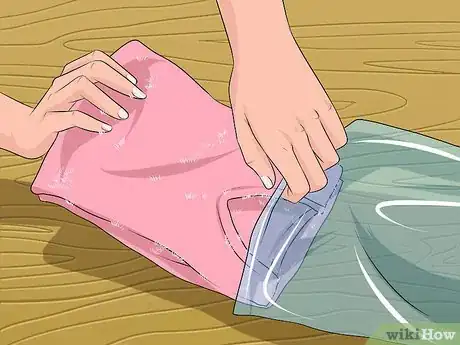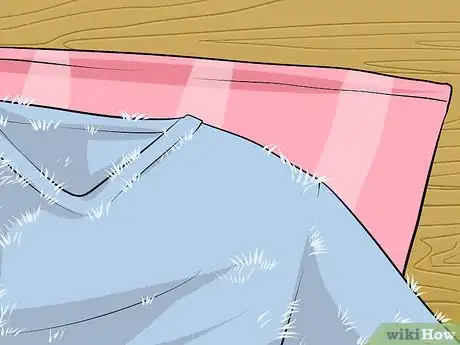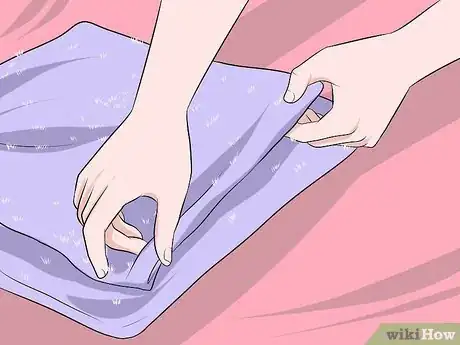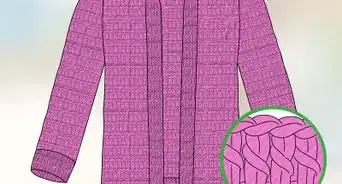This article was co-authored by Robert Shapiro and by wikiHow staff writer, Jessica Gibson. Robert Shapiro is a Laundry Specialist and the General Manager at Milt & Edie's Drycleaners & Tailoring Center in Burbank, California. With more than a decade of experience, he specializes in dry cleaning, stain removal, tailoring, alterations, and green and eco-friendly cleaning processes. Robert has also been featured in publications such as Cleaner and Launderer Magazine.
This article has been viewed 113,163 times.
Angora sweaters are known for being beautiful and soft. Unfortunately, they're also known for their tendency to shed on everything. Angora is a type of delicate wool that comes from the angora rabbit. While there's not a lot you can do to completely stop this shedding, you can control it to some extent. And, proper maintenance can prolong the life of your sweater.
Steps
Freezing Angora to Prevent Shedding
-
1Determine if your sweater can be frozen. This method of freezing works best for angora sweaters that are blended with another material. If your sweater is 100% angora, your sweater will still shed because of the high amount of angora. The freezing method relies on making the fibers easier to shake out. So, after you freeze the sweater you can vigorously shake out all of the fibers that will fall out so they come out at once instead of throughout the day.
- Many angora sweaters you purchase are mixtures of a low percentage of angora and other wools (like cashmere or wool from sheep) and synthetic fibers like viscose or polyester. These combinations can minimize shedding.
-
2Check your angora sweater for snags or stains. This way, you can care for the problems and wear the sweater as soon as it's out of the freezer. To deal with snags, take a sewing needle and push or pull the snag through the sweater. Tie a knot in the snag and dab the knot with clear nail polish to hold it in place.[1]
- You can also insert a small crochet hook from the inside of the sweater so that the hook grabs the snag on the outside of the sweater. Carefully pull it back in through the sweater, so the snag ends up on the inside.
- Never pull the snag away from the sweater or cut it off. This could make the sweater start unraveling or create a large hole.
Advertisement -
3Place the sweater in a bag. Fold your angora sweater into a small square. You should be able to fit it in a plastic freezer bag. While you could freeze the sweater without putting it in the plastic bag, the bag prevents the sweater from absorbing any smells from food in the freezer.
- While you might worry that your sweater will freeze solid, it will remain flexible.
- To keep the sweater from creasing while it's freezing, consider layering tissue paper between the folds of the sweater.
-
4Freeze your sweater. Place the bag holding the sweater in the freezer for 3 to 4 hours before you plan on wearing it. Make sure the sweater is laying flat in the freezer so that you don't accidentally create wrinkles while it's freezing. Freezing the sweater will also prevent moth eggs from hatching in the sweater.
- You could also be in the habit of leaving the sweater in the freezer when you're not wearing it. That way, it's always ready for you to wear.
-
5Remove the sweater and shake it. Take the sweater out of the plastic bag and unfold it. Give it a really good shake so that any angora hairs fall out before you wear the sweater. Understand that this method removes most of the hairs, but you'll still shed a little throughout the day so you might want to carry a lint roller to deal with remaining shedding.
- The idea is that freezing the sweater makes the hairs shed all at once instead of over the course of several hours. This is why you'll need to freeze the sweater every time you want to wear it.
Caring For Your Angora Sweater
-
1Rub a pumice stone to stop pilling. Take a pumice stone like one you use for pedicures and gently rub it over any part of your sweater that's starting to pill. The fibers will get caught in the rough texture of the stone. Use light pressure so that you don't pull on the fibers of the sweater. As soon as you feel the sweater start to pull away with the stone, stop rubbing the pumice and remove the pills.
- Avoid pulling the pills since this can damage the angora by pulling the fibers out even more.[2]
-
2Use a humidifier. One of the reasons angora sheds is because the fibers can get statically charged. This means they'll draw other things (like hair or other fibers) to them. To avoid this, place the sweater in a room with a humidifier before you wear it. A humidifier or steam can keep the air from becoming too statically charged. You might need to do this frequently in the winter when the dry air can create static charges.[3]
- Try to cut down on static. Static can easily build up if you blow dry your hair every day, so let your hair air dry instead or use an ionizing hair dryer. These create ions that reduce static electricity.[4]
-
3Wash the sweater only when it needs it. If you're in the habit of wearing a sweater for a short period of time and then washing it, you might be damaging the fibers. Unlike a sweater made from cotton or a synthetic material, angora only needs to be washed when it's truly dirty. You can overwash an angora sweater which will wear out the fibers quickly. Wash your sweater if you notice dirt or sweat on the sweater or if it smells.
- Avoid washing your sweater in a washing machine and never use a dryer.
- You should also keep your sweater out of direct sunlight and never use bleach, since these can ruin the fibers of the sweater.
Washing and Drying Your Angora Sweater
-
1Wash your angora sweater by hand. Turn your sweater inside out. Fill a sink with water that's barely warm and add a little natural soap. Don't add so much soap that you get suds in the water. Add the sweater and let it soak for 20 minutes. Rinse out the sweater while you hold the sweater. Support the sweater and avoid wringing or twisting the sweater.[5]
- If you pull or tug your sweater while it's wet, you might damage or stretch the sweater. This is why you shouldn't wash it in the washing machine, which can twist or knot the fibers.
-
2Dry your angora sweater. Scoop up the angora sweater so that it's still in a lump and lay it flat on a towel. Roll the towel up so that the water from the sweater blots onto the towel. Lay it flat on another dry towel and make sure it's laying in the shape you'd like it to dry. Let it dry overnight. In the morning, turn the sweater over and let the other side dry completely.[6]
- To get most of the water out of the sweater quickly, you can also put it in a salad spinner. Spin until most of the water is collected in the spinner.[7]
-
3Clean your sweater before storing it. If you plan on storing your sweater for a long period of time (like over the summer), be sure to clean it thoroughly. A sweater that's free of dirt or perfume won't attract bugs like moths. Consider folding tissue paper in between the folds of the sweater to prevent creasing.
- Never store your angora sweater by hanging it. You should always fold the sweater so that it keeps its shape.[8]
-
4Reshape your sweater. If you've accidentally stretched or twisted your wet sweater or dried it on a hanger so that it has hanger marks, you can reshape your sweater. Reshape the sweater by blocking it. Wash the sweater again, but this time, avoid pulling and tugging the wet sweater. Lay the flat clean sweater on your drying rack and shape the sweater so that it will dry the way you want it.
- For example, when you lay the sweater flat make sure the arms don't fall or drape over the drying rack. This can make ridges in the sweater when it's dry. Your sweater should be completely flat.
- When you dry clean a sweater, it goes through the dry cleaning process. If the fabric contracts a little, you can steam it.
- If there are stains, the sweater should be wet cleaned.
Community Q&A
-
QuestionCan freezing damage a mohair sweater?
 Community AnswerNo; it actually helps keep it in place.
Community AnswerNo; it actually helps keep it in place.
References
- ↑ http://www.realsimple.com/beauty-fashion/clothing-care/fix-sweater-snag
- ↑ http://organicclothing.blogs.com/my_weblog/2005/12/caring_for_orga.html
- ↑ http://organicclothing.blogs.com/my_weblog/2005/12/caring_for_orga.html
- ↑ http://scienceline.ucsb.edu/getkey.php?key=1935
- ↑ http://organicclothing.blogs.com/my_weblog/2005/12/caring_for_orga.html
- ↑ http://organicclothing.blogs.com/my_weblog/2005/12/caring_for_orga.html
- ↑ http://stylecaster.com/how-to-care-for-your-clothing-101-tips/
- ↑ http://www.stjohnknits.com/garment-care
















-Step-18.webp)






















































